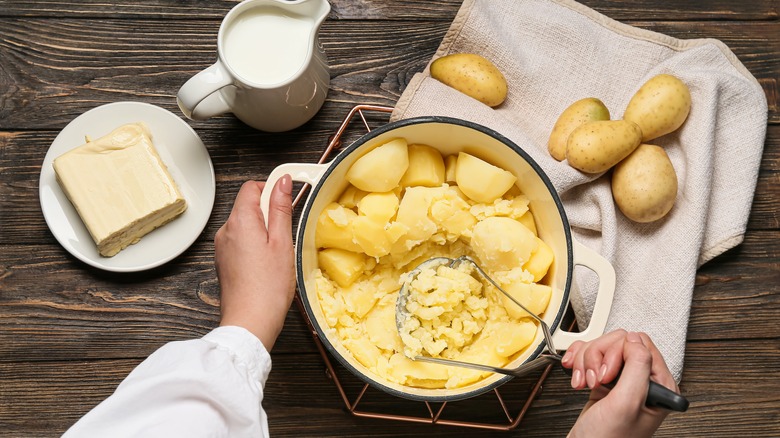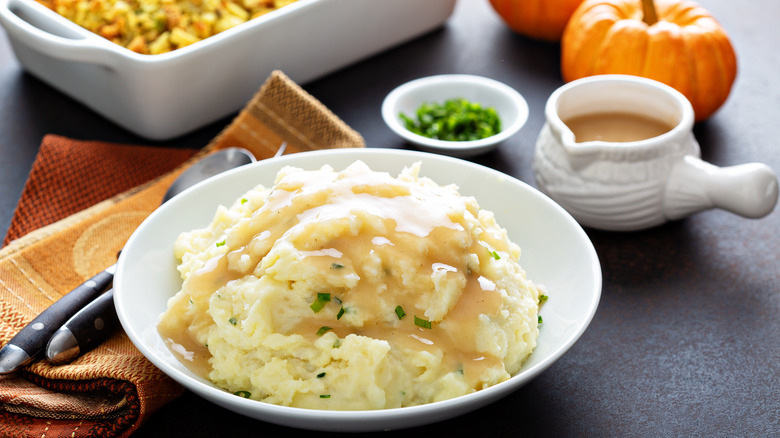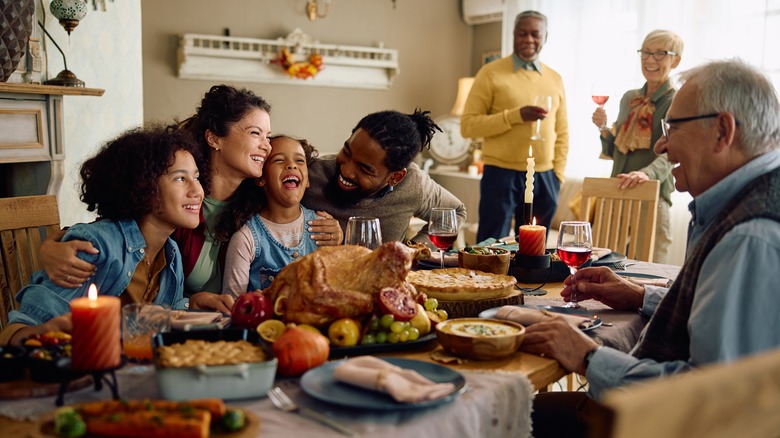How Many Mashed Potatoes You Need For 10 Hungry Friends
You'd think that there'd be some sort of clear-cut equation to guide you when preparing the right amount of food for Thanksgiving (or any other shared meal), but whether it's the turkey or the pie, it's a bit of a guessing game — still you can make an educated guess!
Here's how to make that guess when it comes to mashed potatoes, say, for a group of 10. First up, figure out how much each person is going to eat: The U.S. Department of Agriculture estimates that a single serving of mashed potatoes is 1 cup — that's a little under a half-pound (210 grams or 7.4 ounces, to be precise). However, only about 85% of that is actually potato — the USDA describes the rest as milk, but depending on your preferences, maybe there's butter, cheese, or other flavorings in there. So, a single serving is actually around 6.3 ounces (179 grams) of potato per person. Do the math, and that's 63 ounces of potatoes for a group of ten. If a medium potato weighs around 7.5 ounces (213 grams), then that's around 8 to 9 medium potatoes for the group of 10. But just to be safe (or if you want leftovers), you could bump it up to at least 10 potatoes. Conveniently, that's one medium potato per person, so it's easy to adjust; for example, if you're feeding six, then go for at least six potatoes — more if you want to be extra sure that you'll have enough to feed your crowd.
Other factors to consider
Planning the portions for large meals is really more of an art than a science — with all sorts of variables from how hungry your guests are, to the presence of vegetarians or vegans, and whether or not there are kids at the table, you may need to make adjustments. Most of these should be pretty intuitive: If you know your group of 10 are big eaters, go for more, but if there are five adults and five kids, you can probably dial the quantity back pretty safely. For a large meal like Thanksgiving, bear in mind that there's usually a wide range of dishes, so people might eat just a few bites of each of these items, instead of a full "serving" (that cup of mashed potatoes). So, unless you're up for a ton of leftovers, maybe don't assume overly generous portions for everyone.
Then there's the potatoes themselves: Not all potatoes are created equal, so it's smarter to measure the potatoes for your recipe by weight, not by the number of potatoes. You could use the 6.3 ounces of potato per person number mentioned above, but it might just be easier to just go for a nice, even half-pound per person. So, 5 pounds for 10 people, 4 pounds for eight, and so on, as needed. If you're dealing with smaller eaters, maybe go with one-third of a pound per person.
How do I figure out the right amount of food for other dishes?
If it's possible to get this in-depth by calculating the portions of mashed potatoes alone, then planning the right amount of food for a whole dinner party could be a serious challenge. But there are ways to simplify it. A common rule in the catering world is to provide about a pound of cooked food per dinner guest (and a half-pound for kids). If you're doing a meaty main dish, then you'll want around 6 to 8 ounces of meat per person: For a Thanksgiving turkey, this means buying a turkey that allows 1 to 1.5 pounds of turkey per person. Remember, the turkey will cook down, and all those bones add in extra weight that won't get eaten.
For other dishes, pay attention to the "serving" count on a recipe, and this will help you measure. Of course, this doesn't factor in how hungry people are, but it's a starting point. It's unlikely that you'll always get it exactly right, but don't worry too much — you can treat yourself to leftovers if you're wrong. You'll be so tired from hosting your big dinner party, you'll be happy you have a little extra mashed potatoes to enjoy the next day without having to do any cooking.


